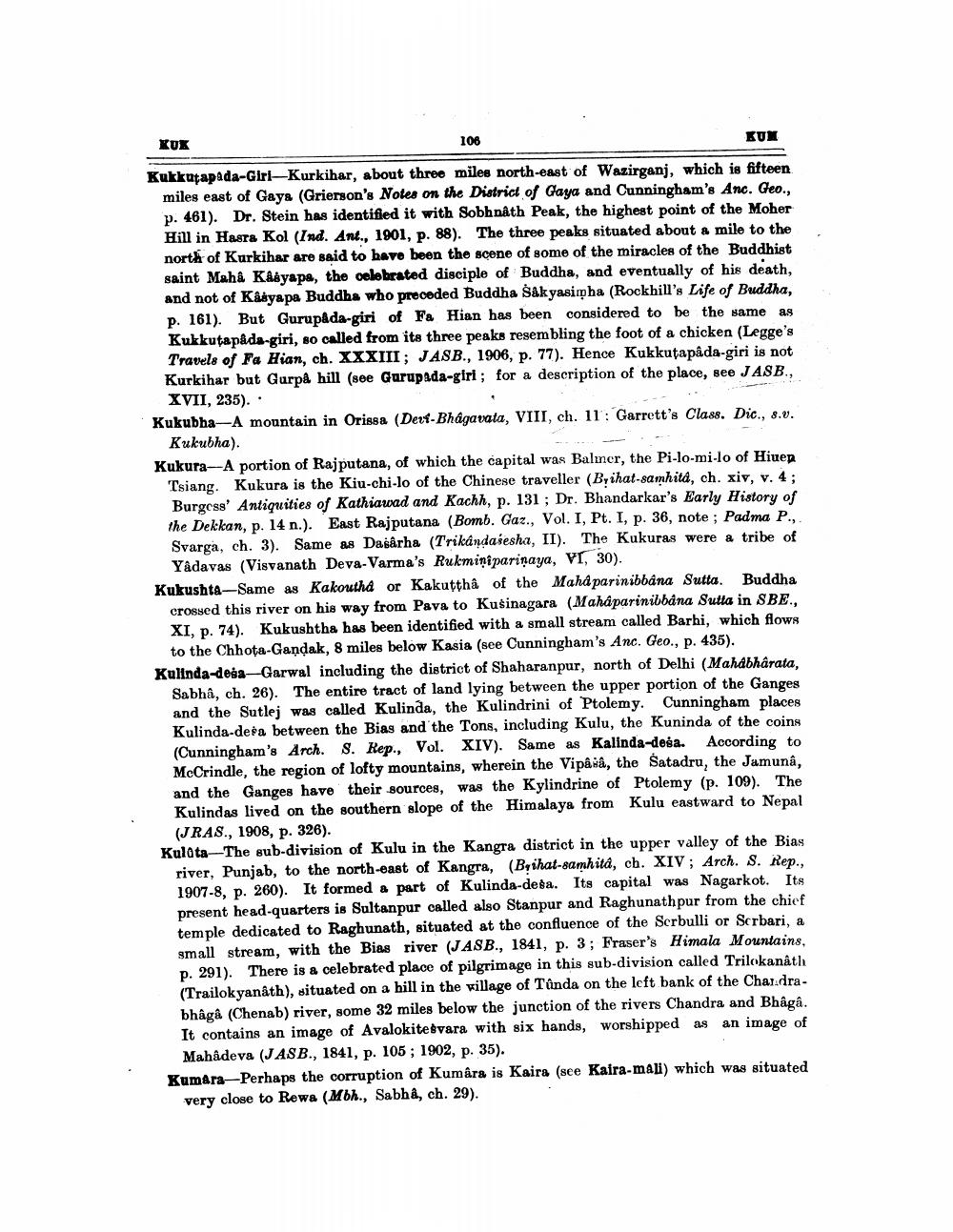________________
KUK
108
KUK
Kukkutapada-Girl-Kurkihar, about three miles north-east of Wazirganj, which is fifteen miles east of Gays (Grierson's Notes on the District of Gaya and Cunningham's Anc. Geo., p. 461). Dr. Stein has identified it with Sobhnáth Peak, the highest point of the Moher Hill in Hasra Kol (Ind. Ant., 1901, p. 88). The three peaks situated about a mile to the north of Kurkihar are said to have been the scene of some of the miracles of the Buddhist saint Mahâ Kâsyapa, the celebrated disciple of Buddha, and eventually of his death, and not of Kâsyapa Buddha who preceded Buddha Såkyasimha (Rockhill's Life of Buddha, p. 161). But Gurupâda-giri of Fa Hian has been considered to be the same as Kukkutapads-giri, so called from its three peaks resembling the foot of a chicken (Legge's Travels of Fa Hian, ch. XXXIII; JASB., 1906, p. 77). Hence Kukkutapâda-giri is not Kurkihar but Gurpå hill (see Gurupada-giri ; for a description of the place, see JASB.,
XVII, 235).
Kukubha-A mountain in Orissa (Dert-Bhagavata, VIII, ch. 11 : Garrett's Class. Dic., 8.v.
Kukubha). Kukura-A portion of Rajputana, of which the capital was Balmer, the Pi-lo-mi-lo of Hiuen
Tsiang. Kukura is the Kiu-chi-lo of the Chinese traveller (Brihat-samhita, ch. xiv, v. 4; Burgess' Antiquities of Kathiawad and Kachh, p. 131 ; Dr. Bhandarkar's Early History of the Dekkan, p. 14 n.). East Rajputana (Bomb. Gaz., Vol. I, Pt. I, p. 36, note; Padma P., Svarga, ch. 3). Same as Dasarha (Trikándaiesha, II). The Kukuras were & tribe of
Yadavas (Visvanath Deva-Varma's Rukminipariņaya, VI, 30). Kukushta-Same as Kakoutha or Kakuttha of the Maha parinibbana Sutta. Buddha
crossed this river on his way from Pava to Kusinagara (Mahaparinibbana Sutla in SBE., XI, p. 74). Kukushtha has been identified with a small stream called Barhi, which flows
to the Chhota-Gandak, 8 miles below Kasia (see Cunningham's Anc. Geo., p. 435). Kulinda-dega-Garwal including the district of Shaharanpur, north of Delhi (Mahabharata,
Sabha, ch. 26). The entire tract of land lying between the upper portion of the Ganges and the Sutlej was called Kulinda, the Kulindrini of Ptolemy. Cunningham places Kulinda-desa between the Bias and the Tons, including Kulu, the Kuninda of the coins (Cunningham's Arch. S. Rep., Vol. XIV). Same as Kalinda-desa. According to McCrindle, the region of lofty mountains, wherein the Vipava, the Satadru, the Jamuna. and the Ganges have their sources, was the Kylindrine of Ptolemy (p. 109). The Kulindas lived on the southern slope of the Himalaya from Kulu eastward to Nepal
(JRAS., 1908, p. 326). Kulta-The sub-division of Kulu in the Kangra district in the upper valley of the Bias
river, Punjab, to the north-east of Kangra, (Bihat-samhita, ch. XIV; Arch. S. Rep., 1907-8, p. 260). It formed a part of Kulinda-desa. Its capital was Nagarkot. Its present head-quarters is Sultanpur called also Stanpur and Raghunathpur from the chief temple dedicated to Raghunath, situated at the confluence of the Serbulli or Serbari, a small stream, with the Bias river (JASB., 1841, p. 3; Fraser's Himala Mountains. p. 291). There is a celebrated place of pilgrimage in this sub-division called Trilokanath (Trailok yanath), situated on a hill in the village of Tanda on the left bank of the Chandrabhågå (Chenab) river, some 32 miles below the junction of the rivers Chandra and Bhaga. It contains an image of Avalokitesvara with six hands, worshipped as an image of
Mahadeva (JASB., 1841, p. 105; 1902, p. 35). Kumara-Perhaps the corruption of Kumâra is Kaira (see Kaira-mall) which was situated
very close to Rewa (Mbh., Sabha, ch. 29).




